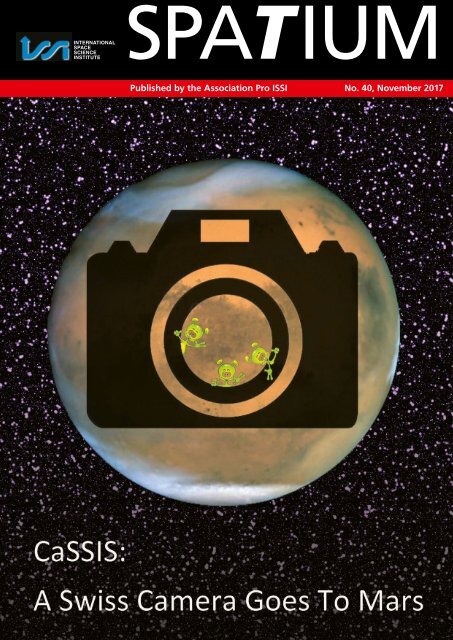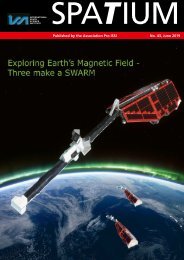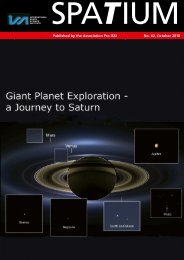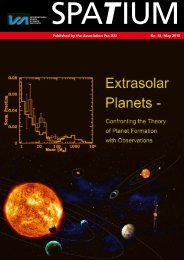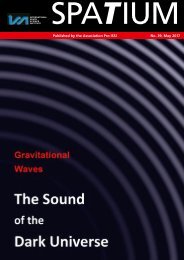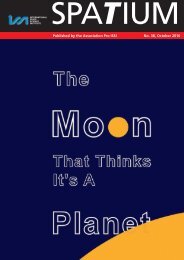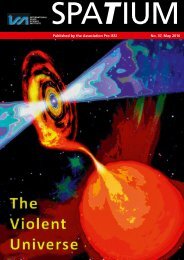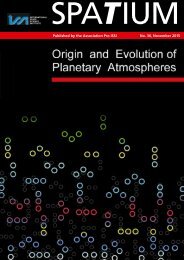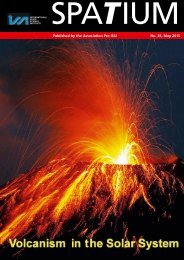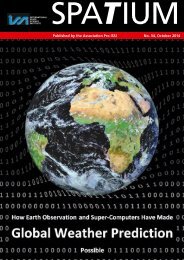CaSSIS: A Swiss Camera Goes To Mars
SPATIUM Volume 40 by Nicolas Thomas
SPATIUM Volume 40 by Nicolas Thomas
You also want an ePaper? Increase the reach of your titles
YUMPU automatically turns print PDFs into web optimized ePapers that Google loves.
INTERNATIONAL<br />
SPACE<br />
SCIENCE<br />
INSTITUTE<br />
SPATIUM<br />
Published by the Association Pro ISSI No. 40, November 2017
Editorial<br />
When I am in Rome, a visit to<br />
Campo dei Fiori is one of my priorities.<br />
The place is a charming<br />
venue today where farmers offer<br />
fragrant flowers, vegetables and the<br />
like, while some 400 years ago, one<br />
of humankind’s most courageous<br />
thinkers payed for intellectual freedom<br />
with his life.<br />
On a cold winter day in February<br />
1600, a handful of menials pile<br />
firewood on Campo dei Fiori.<br />
They prepare the stake for a haggard<br />
Dominican priest, who has<br />
passed the last seven years in nearby<br />
Castel Sant’Angelo’s muggy<br />
prisons. His misdoing is to fancy<br />
there could be an infinite Universe<br />
and uncountable civilizations out<br />
there. <strong>To</strong> the Roman inquisition,<br />
this is a clear case of heresy. The<br />
next day, on 17 February, Giordano<br />
Bruno dies in the flames. His bravery,<br />
however, grants him immortality<br />
in humanity’s history.<br />
Times have changed a little bit:<br />
those, who dream of extra-terrestrial<br />
life and participate in its discovery,<br />
enjoy the great public’s admiration<br />
today.<br />
When it comes to the search for<br />
alien life, <strong>Mars</strong> plays a prominent<br />
role. The current view is that this<br />
planet was very life-friendly in its<br />
early days, and that life may have<br />
emerged there more or less simultaneously,<br />
as it did here on Earth.<br />
Unfortunately, however, the Red<br />
Planet took another way in its evolution<br />
than our Blue Planet: <strong>Mars</strong><br />
became cold and dry, hostile to any<br />
life on its surface, while on Earth,<br />
every corner brims over with animate<br />
beings. Why that difference?<br />
Could our home planet eventually<br />
take the same route as <strong>Mars</strong>? The<br />
search for life on <strong>Mars</strong> helps understand<br />
its history and no less that<br />
of our home planet.<br />
The current issue of Spatium pays<br />
homage to one of the teams rushing<br />
after some of the elusive signs<br />
of Martian life that research could<br />
get hold of so far. It was merely a<br />
little trace gas in its atmosphere.<br />
Yet, it convinced the European<br />
Space Agency to implement a<br />
dedicated mission to <strong>Mars</strong> and the<br />
scientists at the University of Bern<br />
to bring forward a cutting-edge<br />
camera to find out where the trace<br />
gas comes from. We are proud to<br />
present our readers herewith the<br />
summary of Professor Nicolas<br />
Thomas’ fascinating report for the<br />
Pro ISSI audience on 8 June 2016.<br />
Meanwhile, their camera has made<br />
the first fly-by around <strong>Mars</strong> confirming<br />
the anxiously waiting<br />
team in Bern its perfect functionality<br />
to start the scientific mission<br />
in March 2018. If there is any life<br />
there, they should find it!<br />
Hansjörg Schlaepfer<br />
Brissago, October 2017<br />
Impressum<br />
ISSN 2297–5888 (Print)<br />
ISSN 2297–590X (Online)<br />
Spatium<br />
Published by the<br />
Association Pro ISSI<br />
Association Pro ISSI<br />
Hallerstrasse 6, CH-3012 Bern<br />
Phone +41 (0)31 631 48 96<br />
see<br />
www.issibern.ch/pro-issi.html<br />
for the whole Spatium series<br />
President<br />
Prof. Adrian Jäggi,<br />
University of Bern<br />
Layout and Publisher<br />
Dr. Hansjörg Schlaepfer<br />
CH-6614 Brissago<br />
Printing<br />
Stämpf li AG<br />
CH-3001 Bern<br />
SPATIUM 39 2
<strong>CaSSIS</strong>: A <strong>Swiss</strong> <strong>Camera</strong> <strong>Goes</strong><br />
<strong>To</strong> <strong>Mars</strong> 1<br />
By Professor Nicolas Thomas, University of Bern<br />
Introduction<br />
This issue of Spatium is devoted to<br />
<strong>Mars</strong>, Fig. 1. The careful reader<br />
might remark to his surprise that<br />
it is not the first time that Spatium<br />
is about the Red Planet 2 . Yet, there<br />
are valuable reasons for doing so:<br />
firstly, amongst all cosmic objects,<br />
<strong>Mars</strong> stands out as being the nearest<br />
planet to Earth. This facilitates<br />
its exploration; it may even allow<br />
exploration by humans in the near<br />
future. Secondly, its surface conditions<br />
are the most similar to those<br />
on our home planet and they may<br />
have been even more so in the distant<br />
past. Last but perhaps most importantly,<br />
<strong>Mars</strong> is also the nearest<br />
celestial body that might harbour<br />
some forms of life 3 (or may have<br />
done so in the past).<br />
Other hot spots in the solar system<br />
that might offer suitable conditions<br />
for life are in the oceans under the<br />
thick ice sheet on Jupiter’s moon<br />
Europa, or even more speculatively,<br />
under the ice cover of Enceladus, a<br />
Saturnian satellite. Much, much<br />
farther out, some of the innumerable<br />
planets circling stars other than<br />
the Sun might equally be capable<br />
of harbouring life. Yet, the exploration<br />
of those distant worlds poses<br />
technical challenges that are far<br />
greater than exploring the Red<br />
Planet.<br />
When it comes to searching for<br />
present or extinct life, the first step<br />
is the detailed mapping of the planetary<br />
surface. This applies not only<br />
to the topography, but also to the<br />
detection and location of any possible<br />
traces of life, such as for instance<br />
waste products. <strong>To</strong> this end,<br />
one looks for the outcome of the<br />
terrestrial organisms’ metabolism<br />
in the hope that in an alien world<br />
similar forms of life would produce<br />
similar waste products. Here, trace<br />
gases come into play; these are gaseous<br />
components of the atmosphere<br />
in minute concentrations. If<br />
such gases of potentially biologic<br />
origin can be found, the next step<br />
is to pinpoint their sources to further<br />
direct research to these specific<br />
parts of the planetary surface.<br />
This is exactly the mission objective<br />
of the European Space Agency’s<br />
Trace Gas Orbiter, of which one<br />
of the instruments is the Colour<br />
and Stereo Surface Imaging System,<br />
<strong>CaSSIS</strong>.<br />
Much progress has been made in<br />
the last few years; so it is no wonder<br />
that Spatium addresses <strong>Mars</strong><br />
again. The reader will gladly notice<br />
that there are many further<br />
good reasons to do so, be it only<br />
the fact that <strong>Swiss</strong> scientists and engineers<br />
are proudly contributing<br />
systems that are currently investigating<br />
the Red Planet …<br />
Fig. 1: Earth and <strong>Mars</strong> compared: The Red Planet is roughly half the size of our<br />
home planet with a mass of about 12% of the Earth’s. It circles the Sun on an orbit<br />
about 50% larger, which translates into a solar irradiation of some 43% as compared<br />
to Earth. The Red Planet has practically no atmosphere; the iron oxide on its surface<br />
provides it a tawny tint. In contrast, Earth has a relatively dense atmosphere<br />
and oceans giving a bluish shading. (Credit: NASA, Jet Propulsion Laboratory)<br />
1<br />
The text constitutes a free interpretation of Prof. Thomas’ lecture for the Pro ISSI audience on 8 June 2016.<br />
It was drafted by Dr. Hansjörg Schlaepfer and revised by Prof. Thomas.<br />
2<br />
See for instance Spatium no. 5: Earth, Moon and <strong>Mars</strong> by Johannes Geiss, June 2000.<br />
3<br />
When talking about life in the present context, we have complex organisms in mind that are similar to what we find on<br />
Earth in that their cells contain water as the key solvent. This definition is by far not conclusive; indeed, nothing is<br />
trickier than the definition of life including possible extra-terrestrial forms (see also Spatium no. 16: Astrobiology by<br />
Oliver Botta, July 2006).<br />
SPATIUM 39 3
A Brief History<br />
of <strong>Mars</strong><br />
In order to understand the scientific<br />
rationale for assuming present or<br />
extinct life on <strong>Mars</strong>, one has to look<br />
back at the planet’s early history.<br />
Like all the planets in the solar system,<br />
<strong>Mars</strong> evolved 4.6 billion years<br />
ago from a huge disk of dust and<br />
gas 4 from which, in its very centre,<br />
the young Sun emerged. This huge<br />
central body acquired some 98% of<br />
the disk’s mass while leaving the remaining<br />
debris to the emerging<br />
planets and all the other bodies<br />
making up the solar system. The<br />
Sun acquired sufficient mass to produce<br />
a gravity field strong enough<br />
to ignite nuclear fusion processes in<br />
its core, in which, initially, two<br />
hydrogen nuclei combine to one<br />
helium nucleus thereby releasing<br />
tremendous amounts of energy.<br />
This made the Sun shine.<br />
While Earth circles the Sun at a<br />
distance of 150 million km, the<br />
Red Planet’s orbit is some 50%<br />
larger than Earth’s. This greater<br />
orbit leads to lower solar irradiation<br />
and a climate generally colder<br />
than Earth’s. <strong>Mars</strong> is about half the<br />
diameter of the Earth, which translates<br />
into a mass ratio of about 1:8.<br />
This smaller mass of <strong>Mars</strong> is a key<br />
to understanding its dissimilar evolution<br />
as compared to Earth’s. The<br />
planets formed by collisions with<br />
and incorporation of increasingly<br />
larger chunks of material. This<br />
process caused the emerging planets<br />
to absorb much kinetic energy,<br />
which as heat energy made them<br />
melt. Later, when the bombardment<br />
ceased, the bodies began<br />
cooling down. <strong>Mars</strong>, due to its<br />
smaller mass, cooled faster than<br />
Earth. Therefore, from a geologic<br />
point of view, <strong>Mars</strong> is probably a<br />
dead planet today: there are no<br />
plate tectonics and even the solar<br />
system’s largest volcano, Olympus<br />
Mons, ceased erupting millions of<br />
years ago. This is an essential aspect<br />
as tectonic activity with its<br />
volcanism and the consequent atmosphere<br />
appears to be an indispensable<br />
requisite for the evolution<br />
and subsistence of life on a planet 5 .<br />
The CO₂ atmosphere of <strong>Mars</strong> is<br />
relatively low pressure (around<br />
1/150th of the Earth’s atmospheric<br />
pressure) and consequently wide<br />
surface temperature swings from<br />
–133 °C lows up to 25 °C highs are<br />
evident precluding water-based life<br />
on its surface most of the time.<br />
In contrast, in its early days, when<br />
<strong>Mars</strong> still had enough heat energy,<br />
it must have possessed a denser atmosphere<br />
allowing liquid water to<br />
exist on its surface, probably in<br />
great quantities as some topologic<br />
features (river beds, gullies, etc.)<br />
suggest.<br />
<strong>To</strong> summarize, <strong>Mars</strong> has passed<br />
through different evolutionary<br />
phases: some areas show strong<br />
pockmarks by impact craters,<br />
while others are smooth and plane.<br />
Since the estimation of the age of<br />
a surface usually takes into account<br />
the density of impacts on a particular<br />
area, the diversity in crater density<br />
suggests different ages of the<br />
various parts of the planetary surface.<br />
Consequently, Martian history<br />
can be divided into four distinct<br />
epochs as described below:<br />
The Pre-Noachian 6<br />
(4.6–4.1 billion years ago)<br />
<strong>Mars</strong> emerged from the protosolar<br />
nebula 4.6 billion years ago. It continued<br />
acquiring mass as a result of<br />
impacts with bodies crossing its orbit<br />
during the first ~500 million<br />
years. Even at this time, <strong>Mars</strong> probably<br />
began developing an atmosphere<br />
by impact-related outgassing<br />
from the planet’s mantle. As impact<br />
rates decreased, the temperature<br />
fell, allowing atmospheric water<br />
vapour to condensate and rain<br />
out to form vast oceans. With further<br />
cooling, a first window opened<br />
for the possible emergence of life<br />
in the Martian oceans around 4.4<br />
to 4.3 billion years ago.<br />
4<br />
See Spatium no. 6: From Dust to Planets by Willy Benz, October 2000.<br />
5<br />
See Spatium no. 30: Planets and Life by Tilman Spohn, October 2012.<br />
6<br />
The name Noachian stems from Noachis Terra (lit. “Land of Noah”), a heavily cratered highland region west of the<br />
Hellas basin.<br />
SPATIUM 39 4
The Noachian<br />
(4.1–3.7 billion years ago)<br />
The Noachian includes the period<br />
of the Late Heavy Bombardment<br />
once again with numerous asteroid<br />
and comet impacts, Fig. 2. The Hellas,<br />
Isidis and Argyre basins, the<br />
largest impact structures still visible<br />
on the planet, are the result of<br />
these events, as well as many of the<br />
craters that characterize the southern<br />
highlands.<br />
At the same time, large-scale volcanic<br />
eruptions poured ash and<br />
gases into the atmosphere including<br />
water vapour, which rained out<br />
to erode the valley networks we<br />
still can see today in many basins<br />
and craters.<br />
Because the planet cooled rapidly,<br />
the magnetic dynamo shut down 7 :<br />
<strong>Mars</strong> lost its global magnetic field.<br />
This paved the way for a thinning<br />
of the atmosphere by high energetic<br />
particles from space that<br />
could now strip away atmospheric<br />
molecules. Habitable environments<br />
gradually became smaller<br />
and more localized, but Noachian<br />
Fig. 2: Colorized relief map of Noachis Terra. Colours indicate elevation, with<br />
red highest and blue-violet lowest. The blue feature at bottom right is the northwestern<br />
portion of the giant Hellas impact basin. (Credit: NASA, Arizona State<br />
University)<br />
surface conditions continued to be<br />
favourable for the emergence of<br />
life.<br />
The Hesperian<br />
(3.7–2.9 billion years ago)<br />
The Hesperian 8 period was relatively<br />
calm with fewer impacts<br />
compared to the Noachian. It constitutes<br />
the interim phase between<br />
the humid, warm climate of the<br />
Noachian and the subsequent cold<br />
and dry phase we see on <strong>Mars</strong><br />
today.<br />
During the Hesperian, there was<br />
still considerable volcanism, albeit<br />
at a slowing pace. Volcanoes released<br />
large amounts of sulphur<br />
dioxide and water; the gases reacted<br />
to make sulphuric acid,<br />
which then rained onto the surface.<br />
As a result, the Hesperian is<br />
characterized by extensive sulphate<br />
deposits.<br />
Valley network formation waned<br />
as the climate became colder and<br />
much of the water was probably<br />
locked up as permafrost or subsurface<br />
ice. Episodically, impacts<br />
hit the surface thereby heating the<br />
ground ice and subsurface water.<br />
This gave rise to catastrophic, yet<br />
short-lived, floods creating huge<br />
outflow channels along with the<br />
formation of so-called chaotic<br />
terrain (See Fig. 3 on the next<br />
page).<br />
7<br />
Like Earth, <strong>Mars</strong> is differentiated, that is, it has a dense metallic (iron) core overlain by a rocky (silicate) mantle.<br />
The spinning hot and magnetized iron core creates a magnetic dynamo. This gives rise to electrical currents within the<br />
core that generate the planet’s global magnetic field. This field deviates energetic particles from space preventing them<br />
to hit the planet’s atmosphere and surface.<br />
8<br />
The Hesperian period is named after Hesperia Planum, a moderately cratered highland region northeast of the Hellas<br />
basin.<br />
SPATIUM 39 5
Fig. 3: Kasei Valles. Kasei, the Japanese name for <strong>Mars</strong>, constitute the longest valleys on the Red Planet. They start in a chaotic<br />
region and divide into several arms. This system probably formed because of episodic floods with huge amounts of water<br />
masses seeking their way down to the Chryse Planitia lowlands. The waters are thought to have been released by melting subsurface<br />
processes heated by tectonic activities or asteroid impacts. (Credit: NASA, JPL-CalTech, Arizona State University)<br />
Amazonian<br />
(2.9 billion years ago to<br />
present)<br />
The Amazonian 9 period is characterized<br />
by the absence of largescale<br />
geological and climatic<br />
changes. For much of the period,<br />
the planet’s surface has been dry<br />
and cold.<br />
Late-stage volcanism included the<br />
last eruptions of Olympus Mons<br />
and widespread lava flows elsewhere.<br />
Meanwhile, aeolian (wind)<br />
erosion and deposition shaped large<br />
areas of <strong>Mars</strong>, notably the broad<br />
plains and sand dunes near the<br />
poles.<br />
There is increasing evidence that<br />
<strong>Mars</strong> experiences long-term climate<br />
cycles that have a significant<br />
influence on the distribution of<br />
ices. Such long-term climate cycles<br />
may take place over thousands to<br />
millions of years as the axial tilt of<br />
the planet and its distance from the<br />
Sun undergo cyclical changes.<br />
9<br />
The Amazonian period has its name from Amazonis Planitia, which has a sparse crater density over a wide area.<br />
SPATIUM 39 6
The Red Planet<br />
<strong>To</strong>day<br />
Even though <strong>Mars</strong> is very different<br />
from our world, it is nevertheless<br />
the planet resembling our<br />
Earth the most. Its present climate,<br />
however, makes it more than questionable<br />
whether there is still active<br />
life on the Martian surface. Indeed,<br />
none of the rovers inspecting<br />
sites could identify any trace of<br />
current life to date. However, life<br />
could still be active below the surface<br />
where warmer aquifers might<br />
allow water to remain liquid the<br />
entire Martian year round and offer<br />
shelter against the deadly highenergy<br />
radiation from space 10 .<br />
The Atmosphere of <strong>Mars</strong><br />
Compared to Earth, the actual atmosphere<br />
of <strong>Mars</strong> is extremely<br />
thin. Atmospheric pressure on the<br />
surface ranges from a low of 30 Pa<br />
on Olympus Mons to over 1,155<br />
Pa in Hellas Planitia, with a mean<br />
pressure of 600 Pa. The resulting<br />
mean surface pressure is only about<br />
0.6% of that on Earth.<br />
The chemical composition of the<br />
thin Martian atmosphere is also<br />
quite different to the Earth’s. It is<br />
composed mostly of carbon dioxide,<br />
whereas the Earth’s atmosphere<br />
holds some 78% nitrogen. Its<br />
atmosphere is dusty giving the<br />
Martian sky a tawny reddish hue<br />
when seen from the surface. It<br />
would also be noticeable to someone<br />
on the surface that the brightness<br />
of the sky is highly non-uniform<br />
– unlike on the Earth where<br />
a cloudless sky is uniformly blue to<br />
a first approximation. This highlights<br />
a fundamental difference between<br />
the two planets. On <strong>Mars</strong>,<br />
dust scatters light in the atmosphere<br />
whereas on Earth it is mostly<br />
the gas molecules that do the<br />
scattering.<br />
Methane<br />
Methane is one of the many trace<br />
gases in the Martian atmosphere.<br />
Yet, it causes a disproportionate interest<br />
amongst scientists, as on<br />
Earth, this gas is mostly the product<br />
of biological and anthropogenic<br />
processes. (Since the industrial<br />
revolution Man has had a<br />
significant impact on atmospheric<br />
methane concentrations, increasing<br />
them by roughly 250%.) It is<br />
also well-known as an important<br />
greenhouse gas. The methane<br />
found on <strong>Mars</strong>, so the speculation<br />
goes, could therefore be of biological<br />
origin as well indicating the<br />
presence of life beneath the<br />
surface.<br />
Several observations underpin this<br />
hypothesis.<br />
Firstly, methane occurs in the Martian<br />
atmosphere in extended<br />
plumes only, the profiles of which<br />
imply that it is released from discrete<br />
regions. Currently, there are<br />
three such areas, of which the most<br />
important plume features some<br />
19,000 metric tons of methane,<br />
with an estimated source strength<br />
of 0.6 kilograms per second.<br />
Secondly, observational data suggest<br />
that water once flowed over these<br />
regions, which could have supported<br />
the emergence of life there.<br />
Thirdly, most challenging is the fact<br />
that in the Martian atmosphere<br />
methane has a life expectancy of<br />
50–200 years. Thus, its presence<br />
requires an active source that compensates<br />
for the losses incurred by<br />
dissociation.<br />
One of the hypotheses to explain<br />
these observations is that underground<br />
liquid water areas would<br />
be able to provide a habitat for microorganisms,<br />
which release methane<br />
as a waste product. If the methane<br />
is of biological origin, two<br />
scenarios may apply:<br />
1. Long-extinct microbes, which<br />
disappeared millions of years<br />
ago, have left the methane frozen<br />
in the Martian upper subsurface,<br />
and this gas is released<br />
into the atmosphere today as<br />
temperatures and pressure near<br />
the surface change, or<br />
2. Some very resistant methaneproducing<br />
organisms still survive.<br />
One way to confirm the<br />
biological origin of methane<br />
would be to measure the isotope<br />
10<br />
Recently, scientists found complex multi-cellular organisms in depths down to 3.6 km in the deep mines in South<br />
Africa, see Nature 474, 79–82, (02 June 2011). These may be analogous habitats as those subsurface aquifers on <strong>Mars</strong>.<br />
SPATIUM 39 7
atios of carbon and hydrogen,<br />
the two elements of methane.<br />
Life on Earth tends to use lighter<br />
isotopes, for example, more 12 C<br />
than 13 C, because this requires<br />
less energy for bonding. Yet to<br />
answer this question, scientists<br />
must first get hold of some samples<br />
of the Martian methane.<br />
While the hypothesis of a connection<br />
to active biology is highly intriguing,<br />
it is important to note<br />
that other sources (e.g. volcanism)<br />
might also contribute to the methane<br />
budget.<br />
Summary<br />
The European<br />
Space Agency’s<br />
Exo<strong>Mars</strong><br />
Programme<br />
In the framework of the ESA Cosmic<br />
Vision 11 programme, there is a<br />
theme devoted to planets and life<br />
entitled “Life and Habitability in<br />
the Solar System”. Under this title,<br />
ESA runs the Exo<strong>Mars</strong> Programme<br />
2016–2020 addressing the question<br />
of whether life ever existed on<br />
<strong>Mars</strong> and preparing new technologies<br />
paving the way for a future<br />
<strong>Mars</strong> sample return mission in the<br />
2020’s.<br />
The Exo<strong>Mars</strong> programme contains<br />
two missions carried out in cooperation<br />
with Roscosmos 12 :<br />
––<br />
The 2016 mission consists of the<br />
Trace Gas Orbiter (TGO) including<br />
a landing demonstrator<br />
module, and<br />
––<br />
The 2020 mission includes a<br />
rover that will carry a drill and a<br />
suite of instruments dedicated to<br />
exobiology and geochemistry<br />
research.<br />
Evidence suggests that <strong>Mars</strong> was<br />
significantly more habitable during<br />
early epochs than it is today.<br />
Life may have emerged in the distant<br />
past as it did on our own<br />
planet. Yet, whilst on Earth conditions<br />
for life remained more or<br />
less favourable for the subsistence<br />
of life, dramatic climate changes<br />
followed on <strong>Mars</strong> that make the<br />
surface a hostile environment today.<br />
Yet, by analogy to findings on<br />
Earth, life may still be active below<br />
the surface for which the<br />
methane plumes could act as precious<br />
signposts. Advancing our<br />
knowledge regarding these potential<br />
sites of life is the key goal of<br />
the European Space Agency’s Exo-<br />
<strong>Mars</strong> programme, which we are<br />
going to address now.<br />
Fig. 4: The Trace Gas Orbiter in an artist’s impression. Clearly visible are the<br />
very large solar panels required for providing the spacecraft with enough electrical<br />
energy under the reduced solar illumination conditions at the Martian orbit. (Credit:<br />
ESA)<br />
11<br />
Cosmic Vision is the name of the current phase of ESA’s Science Programme.<br />
12<br />
Roscosmos is the space agency of the Russian Federation.<br />
SPATIUM 39 8
The Exo<strong>Mars</strong> Trace Gas<br />
Orbiter<br />
The Trace Gas Orbiter, Fig. 4, carries<br />
a scientific payload capable of<br />
detecting and characterizing various<br />
trace gases in the Martian atmosphere.<br />
It will also investigate<br />
the location and nature of the<br />
sources that produce these gases.<br />
<strong>To</strong> cope with these objectives, the<br />
TGO carries the following four instruments<br />
aboard:<br />
––<br />
NOMAD: The Nadir and Occultation<br />
for <strong>Mars</strong> Discovery combines<br />
three spectrometers (two in the<br />
infrared and one in the ultraviolet<br />
spectrum) to perform highsensitivity<br />
orbital identification<br />
of atmospheric components via<br />
both solar occultation 13 and direct<br />
reflected-light nadir observations<br />
14 . The Belgian Institute<br />
for Space Aeronomy is responsible<br />
for this instrument.<br />
––<br />
<strong>CaSSIS</strong>: The Colour and Stereo<br />
Surface Imaging System is a<br />
high-resolution, 4.5 m per pixel<br />
colour stereo camera for taking<br />
images in natural colours and for<br />
the production of accurate digital<br />
elevation models of the Martian<br />
surface. This camera is a<br />
contribution by the University of<br />
Bern together with Italian and<br />
Polish partners.<br />
––<br />
FREND: The Fine-Resolution Epithermal<br />
Neutron Detector is a<br />
neutron detector that can provide<br />
information on the presence<br />
of hydrogen, in the form of water<br />
or hydrated minerals, in the<br />
top one meter of the Martian<br />
surface. This package is a contribution<br />
from the Space Research<br />
Institute (IKI) in Moscow.<br />
FREND measures the flux of neutrons<br />
from the Martian surface.<br />
These neutrons are produced by<br />
the continuous cosmic ray bombardment<br />
that interacts with the<br />
Fig. 5: Artist’s impression of the Exo<strong>Mars</strong> 2016 Trace Gas Orbiter seen from<br />
the planet-facing side. The four instruments (<strong>CaSSIS</strong>, NOMAD, FREND and<br />
ACS) are mounted on the exterior of the spacecraft to facilitate undisturbed observation<br />
of the planet’s surface. <strong>To</strong> the right is Schiaparelli, the entry, descent and<br />
landing demonstrator module. The large solar arrays are partially cut away to highlight<br />
the spacecraft’s body. (Credit: ESA)<br />
––<br />
ACS: The Atmospheric Chemistry<br />
Suite consists of three infrared<br />
instruments that help investigate<br />
the chemistry and structure of<br />
the Martian atmosphere. ACS<br />
complements NOMAD by extending<br />
the coverage at infrared<br />
wavelengths and by taking images<br />
of the Sun to better analyse<br />
the solar occultation data. This<br />
package is a contribution from<br />
the Space Research Institute<br />
(IKI) in Moscow.<br />
13<br />
The term solar occultation refers to an operational mode, whereby the instrument looks toward the Sun and examines<br />
the composition of the sunlight that passes through the atmosphere. The atmospheric gases partially occult the sunlight<br />
at specific wavelengths thus allowing the instrument to determine the local chemical composition of the atmosphere.<br />
14<br />
The term reflected-light nadir designates a mode whereby the instrument looks directly downward toward the surface<br />
and observes the sunlight scattered by the atmospheric constituents. This is a complementary way of analysing the composition<br />
of the atmosphere.<br />
SPATIUM 39 9
first few metres of rock. The cosmic<br />
rays are sufficiently energetic<br />
to break apart atoms, releasing<br />
high-energy neutrons that are then<br />
slowed down and absorbed by the<br />
nuclei of elements in the surrounding<br />
material. Not all the neutrons<br />
are captured though, many escape,<br />
creating a leakage flux of neutrons<br />
that the FREND instrument will<br />
observe. The distribution of neutron<br />
velocities, which depends<br />
upon how much they were slowed<br />
down before escaping, can reveal<br />
much about the surface material<br />
since it depends on the composition<br />
of that material, primarily on<br />
its hydrogen content. The hydrogen<br />
serves as an indicator of the<br />
presence of water.<br />
TGO Timeline<br />
The Exo<strong>Mars</strong> programme will follow<br />
with the Surface Science Platform<br />
and the Exo<strong>Mars</strong> Rover in<br />
2020. For these probes as well as<br />
for NASA spacecraft, the TGO<br />
will operate as a communication<br />
link with Earth until 2022.<br />
The Colour and Stereo<br />
Surface Imaging System<br />
(<strong>CaSSIS</strong>)<br />
In order to locate potential sources<br />
of trace gases on the planetary surface<br />
as well as to qualify potential<br />
sites for future landes missions, a<br />
high-resolution camera is required.<br />
This is the scope of <strong>CaSSIS</strong>, proposed<br />
by Prof. Nicolas Thomas and<br />
his team at the University of Bern.<br />
He has overall responsibility for the<br />
programme (the Principal Investigator<br />
in the space argot) together with<br />
the Co-Principal Investigator Gabriele<br />
Cremonese of the Astronomical<br />
Observatory of Padua,<br />
Italy.<br />
Specifically, <strong>CaSSIS</strong> serves to:<br />
––<br />
Characterize the sites, which<br />
have been identified as potential<br />
sources of trace gases.<br />
––<br />
Investigate dynamic surface processes<br />
(e. g. sublimation, erosional<br />
processes, volcanism)<br />
which may contribute to the atmospheric<br />
gas inventory.<br />
––<br />
Certify potential future landing<br />
sites by characterizing local<br />
slopes, rocks, and other latent<br />
hazards.<br />
The Exo<strong>Mars</strong> Trace Gas Orbiter<br />
was launched on 14 March 2016 by<br />
a Russian Proton-M rocket from<br />
the Baikonur Cosmodrome in Kazakhstan<br />
and injected into <strong>Mars</strong><br />
orbit on 19 October 2016. The<br />
subsequent aero-braking phase<br />
aims at reducing its speed to a value<br />
suitable for the nominal 400 km<br />
circular orbit. The science activities<br />
start in March 2018 and run for<br />
almost two years.<br />
Fig. 6: The <strong>CaSSIS</strong> flight model on a bench in the University of Bern laboratory.<br />
The yellow/red body on the left is the electronics unit. On the right, the<br />
telescope structure with the four mirrors is displayed. The telescope is cantilevered<br />
off the gold coloured support structure. (Credit: University of Bern)<br />
The TGO delivered the Schiaparelli<br />
lander on 16 October 2016, which<br />
successfully entered the Martian atmosphere<br />
returning significant<br />
amounts of science data. Unfortunately,<br />
however, the radio signal was<br />
lost during descent and the lander<br />
crashed onto the surface.<br />
SPATIUM 39 10
The subsequent chapters will provide<br />
a brief overview of the CaS-<br />
SIS camera which is specifically<br />
designed to obtain colour and stereo<br />
images. The stereo capability<br />
facilitates construction of digital<br />
elevation models – effectively providing<br />
the topography in addition<br />
to the 2-dimensional image.<br />
System Overview<br />
<strong>CaSSIS</strong> sits on the surface-facing<br />
side of the orbiter, see Fig. 5. The<br />
orbiter will rotate about an axis<br />
that will maintain its solar panels<br />
oriented towards the Sun to generate<br />
enough electrical energy<br />
while avoiding solar illumination<br />
of its thermal radiators. This requires<br />
<strong>CaSSIS</strong> to compensate for<br />
the spacecraft’s yaw rotation with<br />
its own mechanism.<br />
The rotation mechanism is able to<br />
turn the entire telescope system by<br />
180° in 15 seconds while its support<br />
structure remains fixed, see<br />
Fig. 6. In order to gather the stereo<br />
pair of images required for the production<br />
of elevation models, the<br />
imager looks 10° ahead of the<br />
spacecraft, as outlined in Fig. 7, to<br />
acquire the first image, then it<br />
turns by 180° to look 10° backwards<br />
to acquire the second picture<br />
of the same surface element.<br />
<strong>CaSSIS</strong> will also deliver high-resolution<br />
imagery of the surface that<br />
allows scientists to investigate<br />
whether specific types of geological<br />
processes might be associated<br />
with trace gas sources and sinks.<br />
The horizontal resolution is of<br />
about five metres per pixel when<br />
Fig. 7: The <strong>CaSSIS</strong> stereo image acquisition principle. During the first part<br />
of the orbit (to the left in this sketch), the optical system acquires swaths perpendicular<br />
to the direction of motion at an angle of 10° to the nadir. Then, the camera<br />
is turned by 180° allowing the same region to be observed from a second direction<br />
inclined -10° to the nadir. This procedure allows the system to obtain<br />
quasi-simultaneous stereo pairs over the full swath width for high-resolution digital<br />
terrain models. The resulting images are transferred to the processing computers<br />
on Earth, which produce the digital elevation model of the terrain along with<br />
the colour images. (Credit: ESA).<br />
the spacecraft is in the nominal orbit<br />
(400 km above the surface).<br />
This resolution equals seeing a<br />
<strong>Swiss</strong> franc at a distance of 2 km!<br />
The digital elevation model of the<br />
terrain will have a resolution of<br />
about six metres in the vertical<br />
direction.<br />
The camera is composed of the following<br />
subsystems:<br />
The Telescope Unit<br />
The telescope unit projects an accurate<br />
image of the Martian surface<br />
on the focal plane assembly. It<br />
was originally conceived as a threemirror<br />
anastigmatic system (offaxis)<br />
with a fold mirror. The tight<br />
time schedule in the TGO programme<br />
required the adaption of<br />
an existing system for a laser communication<br />
terminal to satisfy the<br />
requirements for <strong>CaSSIS</strong>.<br />
The mirror structure is made from<br />
carbon fibre reinforced plastic assuring<br />
excellent stability over the<br />
expected spectrum of thermal and<br />
mechanical loads. This subsystem<br />
was designed and fabricated by<br />
RUAG of Zurich, Switzerland.<br />
SPATIUM 39 11
The Focal Plane Assembly<br />
Fig. 8: The <strong>CaSSIS</strong> telescope unit. The telescope delivers a precise image of the<br />
Martian surface to the focal plane assembly. <strong>To</strong> reach the challenging thermal and<br />
mechanical stability requirements, the unit is made of a carbon fibre reinforced<br />
poly mer structure. The primary mirror (to the right) is 13.5 cm in diameter. (Credit:<br />
University of Bern)<br />
Fig. 9: The focal plane assembly. It serves to convert the incoming light<br />
from the telescope into electrical signals. As <strong>CaSSIS</strong> is intended to provide<br />
colour images, there are four optical filters directly deposited on a silica substrate<br />
that covers the detector unit. The numeric combination of the four data channels<br />
delivers imagery in natural colours. (Credit: University of Bern)<br />
The Focal Plane Assembly converts<br />
the incoming light into electrical<br />
signals. It is a heritage from the BepiColombo<br />
mission – a slightly<br />
adapted flight spare unit from the<br />
SIMBIO-SYS experiment. As can<br />
be seen in Fig. 9, the detector is<br />
covered by a single substrate on<br />
which four colour filters are deposited.<br />
With these four filters, the<br />
detector produces images in four<br />
different colour bands which,<br />
when composed to one single<br />
image, permit the reproduction of<br />
natural colours and scientifically<br />
relevant colour ratios. <strong>To</strong> avoid<br />
blurring by the speed of the spacecraft,<br />
the detector is read-out extremely<br />
quickly with 14-bit digital<br />
resolution.<br />
The Rotation Mechanism<br />
The rotation mechanism rotates<br />
the camera’s optical axis, see Fig. 10.<br />
It connects the telescope unit and<br />
the focal plane assembly to the<br />
spacecraft. This solves two problems:<br />
Firstly, the rotation of the<br />
spacecraft about the nadir direction<br />
can be compensated for. Prior to<br />
image acquisition, the imager can<br />
be rotated, so that the lines are orthogonal<br />
to the direction of motion.<br />
Secondly, the rotation mechanism<br />
can be swivelled by ~180°<br />
to acquire stereo images as outlined<br />
in Fig. 7.<br />
The rotation mechanism’s gear is<br />
made of high-strength titanium alloys,<br />
which are hard-coated to provide<br />
durability. A stepper motor,<br />
connected to the torus shaft via a<br />
SPATIUM 39 12
Fig. 10: The <strong>CaSSIS</strong> Rotation Mechanism. The rotation mechanism holds the<br />
telescope unit and the focal plane assembly on the basic instrument structure, which<br />
in turn is fixed to the spacecraft. It serves to adjust the instrument’s optical axis in<br />
the direction needed, for instance to create the stereo images. (Credit: University<br />
of Bern)<br />
bellow coupling creates the necessary<br />
torque.<br />
The Electronics Unit<br />
The electronics unit provides the<br />
necessary electrical energy to the<br />
various consumers in the camera.<br />
In addition, it performs the first<br />
step in the digital processing chain<br />
of the image data before it is conveyed<br />
to the spacecraft system bus<br />
for transmission to Earth. The<br />
electronics unit comprises three<br />
modules, which assembled with<br />
board-to-board connectors to generate<br />
a complete and compact box.<br />
When the TGO arrived at the Red<br />
Planet on 22 November 2016, the<br />
aero-braking phase began decelerating<br />
the spacecraft to reach its final<br />
400 km orbit. On the occasion<br />
of its first encounter with the<br />
planet, the spacecraft and its instruments<br />
were briefly turned-on to<br />
test the systems. <strong>CaSSIS</strong> took a first<br />
glimpse of the Martian surface and<br />
the imagery returned was absolutely<br />
spectacular (original quote<br />
of the principal investigator Nicolas<br />
Thomas), see Fig. 11 and 12. Most<br />
importantly, they confirmed also<br />
the instrument’s full functionality.<br />
The upper panel of Fig. 11 is composed<br />
of a large number of individual<br />
small framelets. Upon pre-processing<br />
by the electronics unit,<br />
these framelets were transferred to<br />
the spacecraft’s telecom system,<br />
which in turn sent the data to the<br />
ESA’s ground station on Earth.<br />
From here, it went to the University<br />
of Bern. With the help of experts<br />
from the Astronomical Observatory<br />
in Padua, the 3D image<br />
shown in the lower table of Fig. 11<br />
was generated.The colour capability<br />
of the instrument was also<br />
tested and the remarkable picture<br />
of lava flows near Arsia Mons was<br />
returned, see Fig. 12.<br />
Fig. 11: Noctis Labyrinthus: a preliminary reconstruction of a detail of the<br />
Martian surface. The image in the top panel was gathered by <strong>CaSSIS</strong> during a<br />
first fly-by at <strong>Mars</strong> before slowing down to the final orbit. The table below displays<br />
the reconstructed 3D image from the digital elevation model. (Credit: University<br />
of Bern)<br />
<strong>CaSSIS</strong>’s First Pictures from<br />
<strong>Mars</strong><br />
SPATIUM 39 13
Fig. 12: Lava flow near Arsia Mons. This image is particularly interesting because it does not merely show dark streaks<br />
arising from the motion of dust but also a bright region to the upper left which is almost certainly a cloud feature in the lower<br />
atmosphere. The detail evident in the image is exquisite. (Credit: University of Bern)<br />
SPATIUM 39 14
Outlook<br />
The Italian astronomer Giovanni<br />
Schiaparelli 15 became world-famous<br />
in 1877 with his maps of the<br />
Martian surface, which, however,<br />
the space age debunked as fantastic<br />
interpretations of what his eyes<br />
may have seen through his (too)<br />
simple lens telescope. Nevertheless,<br />
his publications stirred up the public’s<br />
fantasy on a large scale and set<br />
the stage for the small green Martians,<br />
the possible artificers of the<br />
long water channels Schiaparelli<br />
was thought to have detected.<br />
The technologies have changed<br />
since Schiaparelli’s time but the<br />
three ingredients of the story have<br />
excitingly remained the same:<br />
<strong>Mars</strong>, water and life. Thanks to an<br />
armada of spacecraft and rovers exploring<br />
the Red Planet in the last<br />
five decades, our understanding<br />
has grown immensely; and all this<br />
tremendous amount of knowledge<br />
points towards the possibility of life<br />
on <strong>Mars</strong> either actual or extinct.<br />
In the meantime, scientists explore<br />
the Red Planet with the currently<br />
available technology of which the<br />
<strong>CaSSIS</strong> camera is an excellent example.<br />
This wonderful piece of<br />
hardware will provide crucial information<br />
about the Martian surface<br />
not least by qualifying landing<br />
sites for future human space<br />
missions.<br />
As Carl Sagan 16 said, “The cosmos is<br />
full beyond measure of elegant truths,<br />
of exquisite interrelationships, of the<br />
awesome machinery of nature.” This<br />
is certainly true for <strong>Mars</strong> in particular<br />
and <strong>CaSSIS</strong> will help to<br />
shed light on that awesome machinery<br />
of nature that is at work<br />
on <strong>Mars</strong>.<br />
This vague option continues<br />
prompting space agencies to implement<br />
missions to <strong>Mars</strong>. Within<br />
perhaps two decades, this planet<br />
may even come into the reach of<br />
human space flight, which then<br />
will give rise to a new chapter of<br />
the <strong>Mars</strong> exploration story.<br />
15<br />
Giovanni Virginio Schiaparelli, 1835, Cuneo, Italy – 1910, Milan,<br />
Italian astronomer.<br />
16<br />
Carl Edward Sagan, 1934, Brooklyn, New York – 1996, Seattle, Washington,<br />
American astronomer, cosmologist, and science communicator.<br />
SPATIUM 39 15
SPATIUM<br />
The Author<br />
Nicolas Thomas gave his first physics<br />
lecture at the tender age of eight.<br />
Like his colleagues, he was asked<br />
to present a topic of interest; and as<br />
at that time, Neil Armstrong had<br />
just set foot on the lunar surface,<br />
young Nicolas decided to give a<br />
presentation on the solar system.<br />
This laudable attempt, however,<br />
was stopped at Jupiter since his time<br />
allowance of two minutes was over<br />
at the giant planet. Notwithstanding<br />
this setback, planetary science<br />
continued to fascinate the youngster<br />
who took up where he left off<br />
by writing a review about the Jovian<br />
satellite, Io, when completing<br />
a Master’s degree in Experimental<br />
Space Physics at the University of<br />
Leicester. This encouraged him to<br />
continue his studies at the University<br />
of York with a thesis about Io’s<br />
atmosphere, which earned him the<br />
Stott prize for the best physics thesis<br />
at the University of York in 1986.<br />
His career then led to the Max<br />
Planck Institute for Aeronomy<br />
(MPAe) of Lindau, where he<br />
worked on the analysis of data<br />
from the Halley Multicolour<br />
<strong>Camera</strong> aboard the Giotto spacecraft.<br />
A further post-doctoral<br />
fellowship allowed him to join<br />
the Space Science Department of<br />
ESA, and then he returned to<br />
MPAe. During that time, he was<br />
also engaged as a visiting scientist<br />
at the Lunar and Planetary Laboratory<br />
at the University of Arizona,<br />
Tucson, and at the Queen’s University<br />
of Belfast. In March 2003,<br />
the University of Bern elected<br />
him as Professor of Experimental<br />
Physics.<br />
Nicolas Thomas is the Principle<br />
Investigator for the Microscope on<br />
the Beagle 2 Lander and the Co-<br />
Principle Investigator of ESA’s<br />
BepiColombo Laser Altimeter<br />
Experiment to Mercury. In addition,<br />
Nicolas Thomas has held<br />
leading responsibilities with numerous<br />
other science instruments<br />
and served in various international<br />
space science teams. Specifically,<br />
he was a Member of the Scientific<br />
Board of the International Space<br />
Sciences Institute 2003–2006 and<br />
later a Member of the ISSI Board<br />
of Trustees (2011-present).<br />
Over the years, Nicolas Thomas<br />
has published over 100 publications<br />
covering the fields of cometary,<br />
Jupiter and <strong>Mars</strong> research. He is<br />
deeply fascinated by the beauties<br />
and miracles of our solar system,<br />
even, as he underlines, as a nonbeliever<br />
that there is life elsewhere<br />
in our solar system. But further out<br />
there? That is another story …<br />
Scientists should maintain skepticism,<br />
he confesses, and base arguments<br />
on facts. One does not have<br />
to “spice up” the stories in our solar<br />
system to fascinate the public.<br />
Just tell them the truth. That is<br />
beautiful enough.


